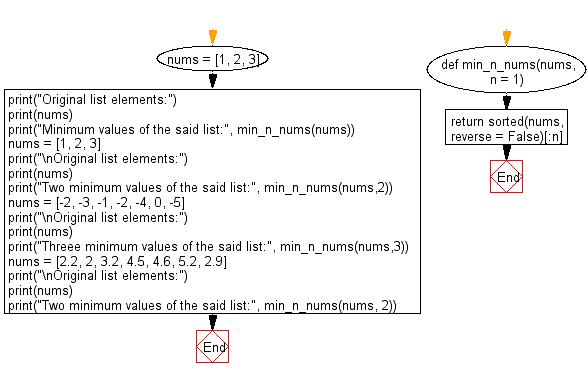Python: Find the n minimum elements from the provided list
Get N Minimum Elements
Write a Python program to get the n minimum elements from a given list of numbers.
- Use sorted() to sort the list.
- Use slice notation to get the specified number of elements.
- Omit the second argument, n, to get a one-element list.
- If n is greater than or equal to the provided list's length, then return the original list (sorted in ascending order).
Sample Solution:
Python Code:
# Define a function 'min_n_nums' that takes a list 'nums' and an optional parameter 'n' (defaulting to 1).
# The function sorts the 'nums' list in ascending order and returns the top 'n' minimum values.
def min_n_nums(nums, n=1):
return sorted(nums, reverse=False)[:n]
# Example 1: Create a list 'nums' with elements [1, 2, 3].
nums = [1, 2, 3]
print("Original list elements:")
print(nums)
# Call 'min_n_nums' to find the minimum value in the list.
print("Minimum values of the said list:", min_n_nums(nums))
# Example 2: Create another list 'nums' with elements [1, 2, 3].
nums = [1, 2, 3]
print("\nOriginal list elements:")
print(nums)
# Call 'min_n_nums' with 'n=2' to find the top two minimum values in the list.
print("Two minimum values of the said list:", min_n_nums(nums, 2))
# Example 3: Create a list 'nums' with negative and zero values.
nums = [-2, -3, -1, -2, -4, 0, -5]
print("\nOriginal list elements:")
print(nums)
# Call 'min_n_nums' with 'n=3' to find the top three minimum values in the list.
print("Three minimum values of the said list:", min_n_nums(nums, 3))
# Example 4: Create a list 'nums' with floating-point values.
print("\nOriginal list elements:")
nums = [2.2, 2, 3.2, 4.5, 4.6, 5.2, 2.9]
print(nums)
# Call 'min_n_nums' with 'n=2' to find the top two minimum values in the list.
print("Two minimum values of the said list:", min_n_nums(nums, 2))
Sample Output:
Original list elements: [1, 2, 3] Minimum values of the said list: [1] Original list elements: [1, 2, 3] Two minimum values of the said list: [1, 2] Original list elements: [-2, -3, -1, -2, -4, 0, -5] Threee minimum values of the said list: [-5, -4, -3] Original list elements: [2.2, 2, 3.2, 4.5, 4.6, 5.2, 2.9] Two minimum values of the said list: [2, 2.2]
Flowchart:

For more Practice: Solve these Related Problems:
- Write a Python program to obtain the n smallest elements from a list after excluding duplicates.
- Write a Python program to find the n minimum values from a list and then output their indices in the original list.
- Write a Python program to extract the n lowest values from a list after converting all elements to absolute values.
- Write a Python program to get the n smallest numbers from a list, ignoring any non-numeric elements.
Python Code Editor:
Previous: Write a Python program to get the n maximum elements from a given list of numbers.
Next: Write a Python program to get the weighted average of two or more numbers.
What is the difficulty level of this exercise?
Test your Programming skills with w3resource's quiz.
